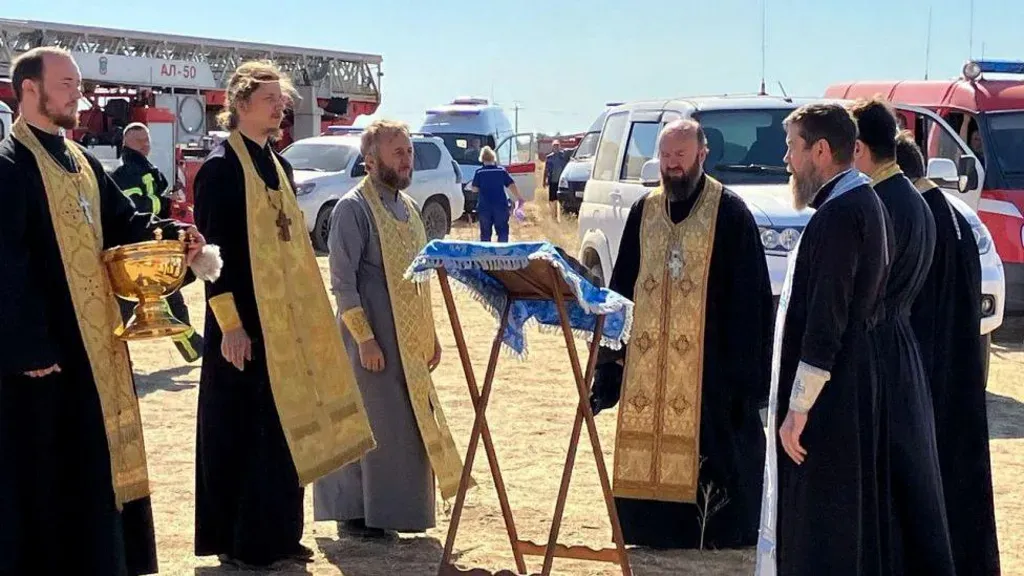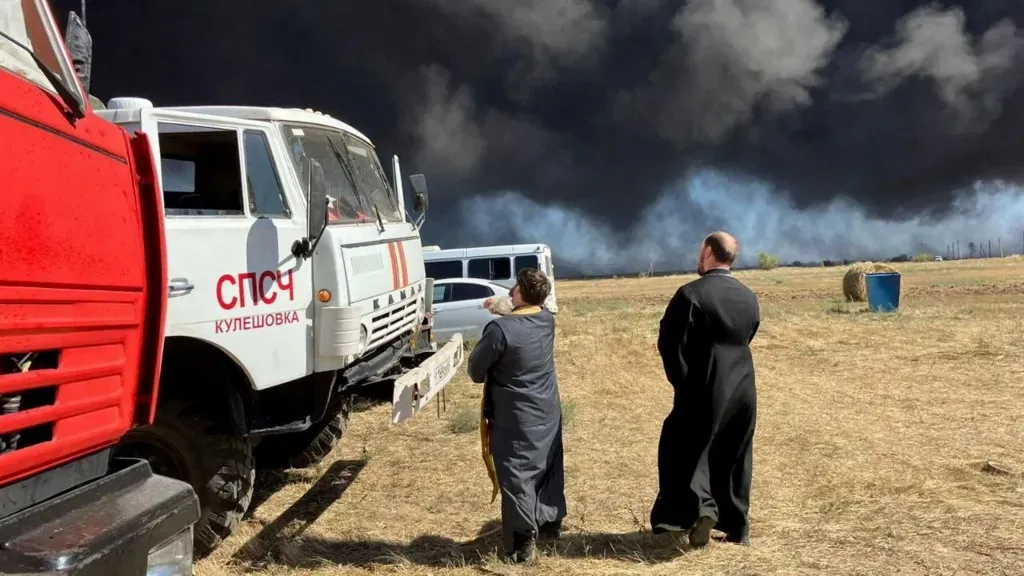Russian Orthodox priests have visited the site of a massive fire at the Proletarsk oil storage facility in southern Russia’s Rostov region. The blaze, which has been burning for three days, was ignited by debris from a Ukrainian drone strike on August 18. More than 500 firefighters are working to extinguish the fire, which has already engulfed around 20 of the 74 fuel storage tanks at the depot.
Orthodox Priests Offer Support
On Wednesday, Orthodox priests from the local Volgodonsk eparchy visited the fire scene to offer spiritual support to the firefighters. They brought with them a large icon of the Unburnt Bush, a symbol regarded as a talisman against fire in the Russian Orthodox tradition. The priests said prayers next to the fire trucks and blessed the firefighting equipment in an effort to boost morale among the emergency workers battling the flames.
“The [priests] spoke with the firefighters and blessed all the fire equipment,” said the Volgodonsk eparchy in a statement. The gesture was intended to provide both spiritual and emotional support to the fire crews as they continued their efforts.
Firefighters Battle the Blaze
Since the initial explosion triggered by the downed drone, firefighters have faced an uphill battle in containing the fire at the oil depot. Despite the scale of the blaze, local officials have reassured residents that there is no immediate threat to nearby residential areas. Authorities have declared a state of emergency but have urged the public not to panic.
According to Rostov regional governor Vasily Golubev, while air defense systems successfully intercepted the Ukrainian drone, debris from the wreckage fell onto the facility, causing diesel fuel to ignite. So far, 41 firefighters have received medical treatment for injuries sustained during their efforts, with five of them being admitted to emergency care due to the intensity of the fire.
The Impact of the Drone Strike
Ukraine has not officially commented on the attack, but the strike fits into a broader pattern of Ukrainian forces targeting Russian oil infrastructure in an attempt to undermine Moscow’s capacity to sustain its ongoing invasion. Since the start of the full-scale invasion in February 2022, Ukrainian forces have increased their use of drone technology to weaken Russian logistical hubs and fuel supplies.

On the same day as the fire at the oil depot, Ukrainian forces reported successfully striking an S-300 air defense system near the Russian city of Novoshakhtinsk, which is also located in the Rostov region. The strike was carried out by the Ukrainian Navy in coordination with other military units, according to a statement from the Ukrainian armed forces.
“Ukraine’s defense forces continue to weaken Russian invaders’ air defense,” the Ukrainian general staff said in a statement on Facebook. The statement also noted that Russian forces have used S-300 systems to attack Ukrainian civilian infrastructure, including residential buildings.
Escalating Drone Activity Over Moscow
In a separate incident, Moscow’s air defenses intercepted 11 Ukrainian drones that were attempting to target the Russian capital overnight. This marks one of the largest drone attacks on Moscow since the conflict began, although no significant damage or casualties were reported.
Moscow’s mayor, Sergei Sobyanin, confirmed the interception and said that the city’s air defenses successfully neutralized the threat. The growing frequency of drone attacks on Moscow suggests a shift in the nature of Ukraine’s long-range tactics, as Kyiv looks to strike deeper into Russian territory.
At the same time, Ukrainian forces have been fending off relentless Russian drone and missile strikes. On Wednesday, Ukrainian air defenses reportedly stopped 50 Russian drones and missiles. Kyiv’s military administration stated that the attack lasted for over nine hours, with a private house damaged by debris and power lines severed in some areas of the city.
Ukrainian Forces Hold Territory in Russia’s Kursk Region
On the ground, Ukraine has made a significant breakthrough by holding territory in Russia’s western Kursk region, following a cross-border incursion that began on August 6. This marks the first time since World War II that Russian territory has been occupied by foreign forces. Ukrainian President Volodymyr Zelensky confirmed that his troops continue to control key areas within Kursk, but he refrained from providing specific details.
In his nightly address, Zelensky said, “Our combat work continues in the Kursk region. We control the designated areas,” without elaborating on the military operations in that region.
Ongoing Battles and Cross-Border Clashes
Ukraine’s continued occupation of territory in Russia’s Kursk region represents a bold move in the conflict, as Russian forces are simultaneously pressing forward towards the city of Pokrovsk in Ukraine’s eastern Donetsk region. Earlier this week, Ukrainian officials reported that Russian troops are now approximately 10 kilometers from the outskirts of Pokrovsk, which serves as a vital logistics hub for the Ukrainian military.
In Russia’s Bryansk region, a neighboring area to Kursk, Governor Aleksandr Bogomaz reported that an incursion attempt by a Ukrainian reconnaissance group was successfully repelled on Wednesday. The growing number of cross-border skirmishes and incursions reflects an escalation in direct confrontations between Ukrainian and Russian forces, as both sides look to gain strategic advantages.
Outlook of the Conflict
As the war continues, both Ukraine and Russia are locked in an intense battle for control over strategic regions and key infrastructure. The fire at the Proletarsk oil storage facility is just one example of the broader conflict’s impact on critical resources. While Ukrainian forces have made progress in weakening Russian defenses, the situation on the ground remains highly volatile.
With both drone strikes and ground incursions increasing in frequency, the coming weeks are likely to see further escalations in the conflict. Whether through symbolic gestures like the blessings from Orthodox priests or large-scale military operations, the fight for control in regions like Rostov, Kursk, and Donetsk continues to shape the course of the war.


